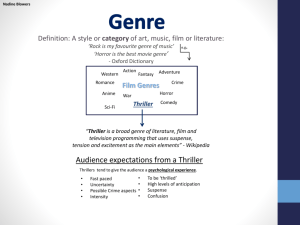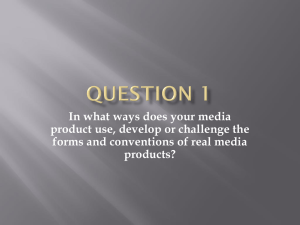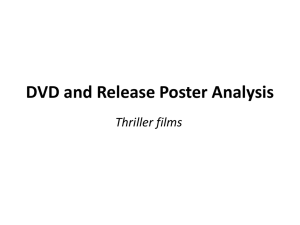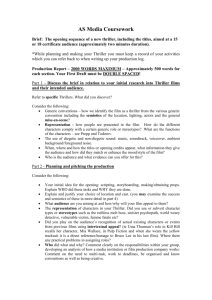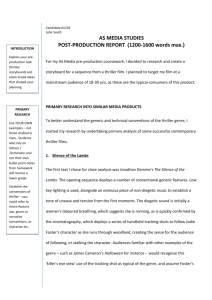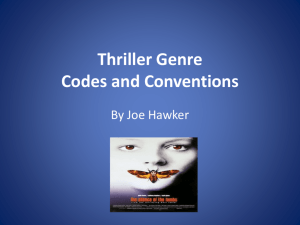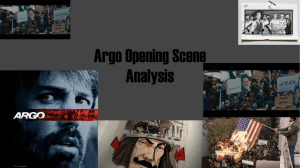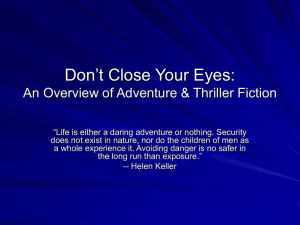Document
advertisement
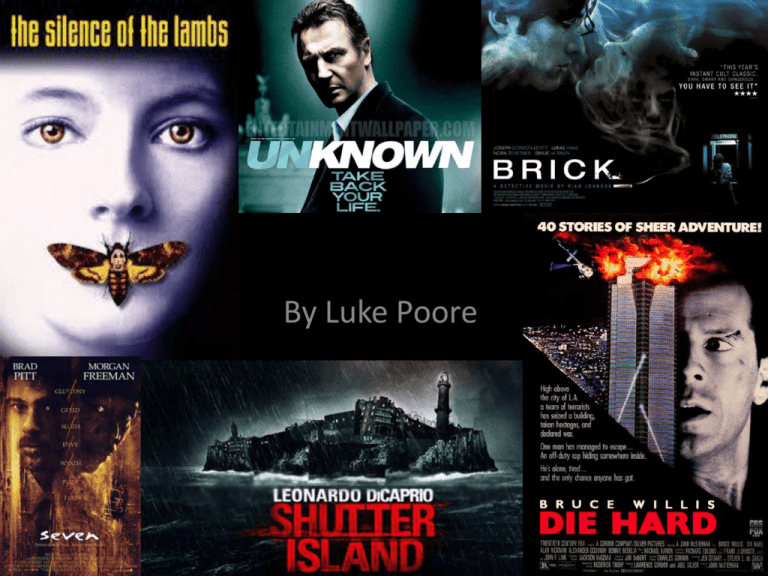
Thrillers By Luke Poore Overview of the Genre A thriller is a film that keeps audiences on the edge of their seat for the whole movie it does this by having a constant state of fear and tension by conveyed by the movies characters. Thrillers also have lots of different sub-genres such as Crime thriller (Sin City), Psychological thriller (Shutter Island), Conspiracy thriller (JFK) and Action thriller (Batman the Dark Knight). Notable thrillers are Die Hard, Taken, Se7en, Tinker Tailor Soldier Spy and Psycho. Most thrillers employ certain directors and actors to create the film. Directors such as Alfred Hitchcock and Martin Scorsese are well known for their thrillers with films like Vertigo and Shutter Island. Some actors are the same and are great in thriller movies like Liam Neeson and Denzel Washington. Narratives and conventions. • • Thriller films often try to replicate real life but will try to show that society is corrupt by introducing a problem which the protagonist will have to overcome e.g. Die hard with John McClain having to overcome terrorists or the two detectives in Se7en trying to find the serial killer. The story is always relatable to the audience which helps them feel the characters emotions and empathise with them. Everyday places/people and extreme events. • Todorov had a structure for thriller films, This will be applied to Se7en 1. a state of equilibrium at the outset; Normal settings and people living ordinary life's 2. a disruption of the equilibrium by some action; Murder(s) by the killer. 3. a recognition that there has been a disruption; Police find the body(ies) 4. an attempt to repair the disruption; Finding clues and evidence 5. a reinstatement of the equilibrium; Killer is killed or captured, Return of peace and normality. Typical characters • • • • The protagonist is mostly always male who either is brave (A Policemen etc.) or becomes brave for the climax of the movie and the main character will usually seek justice in some form e.g. by killing the antagonist or putting them in jail etc. The antagonist will usually have a hidden identity to the character or the character and the audience. This will end up with the big reveal at the end of the movie to whom the antagonist is. Creates a potential twist ending. In mainly crime thrillers there is often a sidekick or some who helps out the main character when they are at a dead end. In some thrillers there might by a wife/girlfriend who is in the story and often ends up as a target/victim for the antagonist or halts the progress of the main character(s). In most thrillers women are the target/victim for their sex appeal. Mise en Scene • • • • • Location sets the theme of the film for example a cityscape might represent a crime thriller/action thriller. Isolated places, police stations and offices are a common setting. Lighting is usually low and dark in most thrillers. Because this creates tension and suspense. Sometimes they will use tints (blue/red) to create an atmosphere. Opening titles usually reflect the genre/style of the film. (grainy and gritty for horror thrillers) Costumes – Antagonist usually in darker clothes and coved up (if you see them). Protagonist depends on the genre but usually everyday clothes and with certain items to display their character and their genre (e.g. crime thriller - trench coats) e.g. detectives, businessmen etc. Never a lot of make up used on characters in thrillers to keep the audience thinking about it’s realism. But makeup is mainly used in thrillers for dead people or to show gore (special effects). Cinematography • A convention of a thriller is that they usually involve a plot twist with a reveal of a character. A montage of shots is also a common occurrence amongst crime thriller to show/reflect the tension or relationship of characters. • Strange camera angles/obtrusive sequence of shots are a common occurrence in psychological/crime thriller this technique is used to disorientate the viewer and feel uncomfortable to reflect the on screen action This technique was a trait of Alfred Hitchcock he used it in Psycho (1960) and Vertigo (1958) • Different camera angles imply different things for example a low angle shot usually implies power whereas a high angle shot implies weakness. • Different camera shots also have different implications for example extreme close up is used to show a specific emotion. Sound • Music is a key non-diegetic sound(s) that is a convention of a thrillers with composers like Hans Zimmer who done the music for Inception and Batman the Dark Knight, it is key because it helps to set the mood and atmosphere for the scene in the film. Most of the sound in thrillers is pleonastic sound which imitates the on screen action e.g. fast pace music for a chase scene. • Ambience is an element of sound that is important to the thriller genre because it is diegetic sound but doesn't have source in the frame and this helps to build and create tension and suspense. Editing • Quick cuts and jump cuts are frequent throughout thrillers this is because it is meant to be accentuate tension and suspense also these cuts are quite unnoticeable this makes the movie flow smoothly. • They are often used during a particularly thrilling scene to build up an atmosphere.

